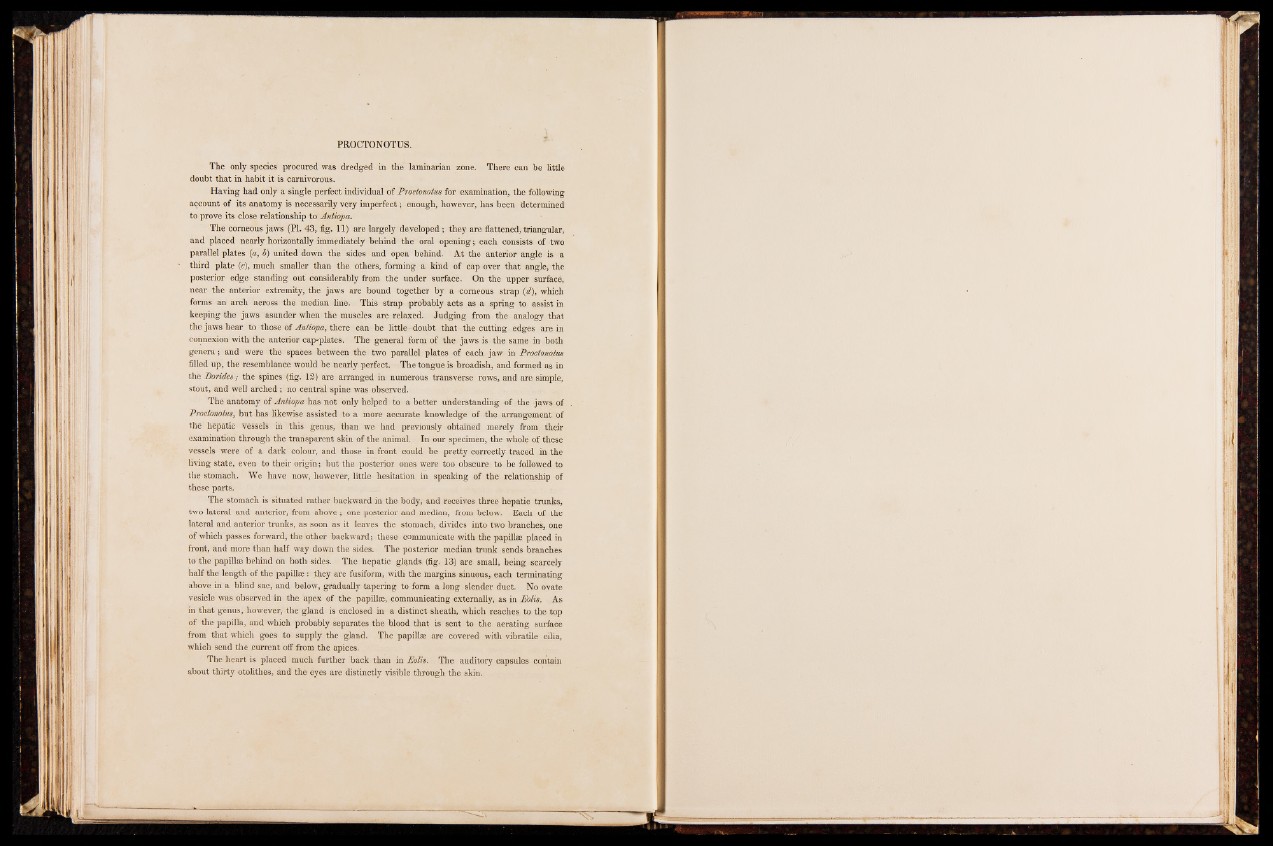
PROCTONOTUS.
The only species procured was dredged in the laminarian zone. There can be little
doubt that in habit it is carnivorous.
Having had only a single perfect individual of jProctonotus for examination, the following
account of its anatomy is necessarily very imperfect; enough, however, has been determined
to prove its close relationship to Antiopa.
The corneous jaws (PI. 43, fig. 11) are largely developed ; they are flattened, triangular,
and placed nearly horizontally immediately behind the oral opening; each consists of two
parallel plates {a, b) united down the sides and open behind. At the anterior angle is a
third plate (c), much smaller than the others, forming a kind of cap over that angle, the
posterior edge standing out considerably from the under surface. On the upper surface,
near the anterior extremity, the jaws are bound together by a corneous strap '(d), which
forms an arch across the median line. This strap probably acts as a spring to assist in
keeping the jaws asunder when the muscles are relaxed. Judging from the analogy that
the jaws bear to those of Antiopa, there can be little- doubt that the cutting edges are in
connexion with the anterior cap-plates. The general form of the jaws is the same in both
genera; and were the spaces between the two parallel plates of each jaw in JProctonotus
filled up, the resemblance would be nearly perfect. The tongue is broadish, and formed as in
the Borides; the spines (fig. 12) are arranged in numerous transverse rows, and are simple,
stout, and well arched ; no central spine was observed.
The anatomy of Antiopa has not only helped to a better understanding of the jaws of
Proctonotus, but has likewise assisted to a more accurate knowledge of the arrangement of
the hepatic vessels in this genus, than we had previously obtained merely from their
examination through the transparent skin of the animal. In our specimen, the whole of these
vessels were of a dark colour, and those in front could be pretty correctly traced in the
living state, even to their origin; but the posterior ones were too obscure to be followed to
the stomach. We have now, however, little hesitation in speaking of the relationship of
these parts.
The stomach is situated rather backward in the body, and receives three hepatic trunks,
two lateral and anterior, from above; one posterior and median, from below. Each of the
lateral and anterior trunks, as soon as it leaves the stomach, divides into two branches, one
of which passes forward, the other backward; these communicate with the papillae placed in
front, and more than half way down the sides. The posterior median trunk sends branches
to the papillae behind on both sides. The hepatic glands (fig. 13) are small, being scarcely
half the length of the papillae: they are fusiform, with the margins sinuous, each terminating
above in a blind sac, and below, gradually tapering to form a long slender duct. No ovate
vesicle was observed in the apex of the papillae, communicating externally, as in Eolis. As
in that genus, however, the gland is enclosed in a distinct sheath, which reaches to the top
of the papilla, and which probably separates the blood that is sent to the aerating surface
from that which goes to supply the gland. The papillae are covered with vibratile cilia,
which send the current off from the apices.
The heart is placed much further back than in Eolis. The auditory capsules contain
about thirty otolithes, and the eyes are distinctly visible through the skin.